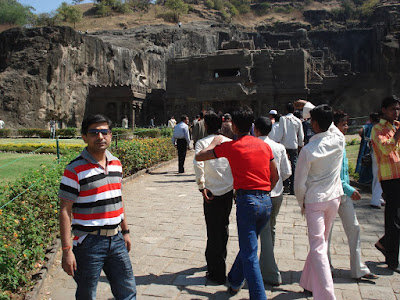Greetings from India, Today I am very happy to write my first post from India after gap of 6 months. I am thankful to all of world wide collectors for sending me nice and wonderful UNESCO World heritage cards. I have received plenty cards. Thanks you all.
Today here I am posting some nice pictures of ELLORA CAVES, The World Heritage site. Which is situated near Aurangabad, about 100 km from my Native place.
Again my deepest gratitude to all my blog visitors and blogger friends. :)

Ellora (Marathi: वेरूळ) is an archaeological site, 30 km (19 mi) from the city of Aurangabad in the Indian state of Maharashtra built by the Rashtrakuta (Kannada: ರಾಷ್ಟ್ರಕೂಟ) rulers. Well-known for its monumental caves, Ellora is a World Heritage Site. Ellora represents the epitome of Indian rock-cut architecture. The 34 "caves" – actually structures excavated out of the vertical face of the Charanandri hills – being Buddhist, Hindu and Jain rock cut temples and monasteries, were built between the 5th century and 10th century. The 12 Buddhist (caves 1–12), 17 Hindu (caves 13–29) and 5 Jain (caves 30–34) caves, built in proximity, demonstrate the religious harmony prevalent during this period of Indian history.
Kailash Temple
Kailash Temple(Kailashnath Temple), also Kailasanatha Temple is one of the 34 monasteries and temples, extending over more than 2 km, that were dug side by side in the wall of a high basalt cliff in the complex located at Ellora, Maharashtra, India, and represents the epitome of Indian rock-cut architecture. It is designed to recall Mount Kailash, the abode of Lord Shiva. While it exhibits typical Dravidian features, it was carved out of one single rock. It was built in the 8th century by the Rashtrakuta king Krishna I.
The Kailash Temple is notable for its vertical excavation -- carvers started at the top of the original rock, and excavated downward, exhuming the temple out of the existing rock. The traditional methods were rigidly followed by the master architect which could not have been achieved by excavating from the front. The architects found to design this temple were from the southern Pallava kingdom.
It is estimated that about 200,000 tons of rocks was scooped out over hundreds of years to construct this monolithic structure. From the chisel marks on walls of this temple, archeologists could conclude that three types of chisels were used to carve this temple.
All the carvings are done in more than one level. A two-storeyed gateway opens to reveal a U-shaped courtyard. The courtyard is edged by a columned arcade three stories high. The arcades are punctuated by huge sculpted panels, and alcoves containing enormous sculptures of a variety of deities. Originally flying bridges of stone connected these galleries to central temple structures, but these have fallen.
Within the courtyard are two structures. As is traditional in Shiva temples, an image of the sacred bull Nandi fronts the central temple housing the lingam. In Cave 16, the Nandi Mandap and main Shiva temple are each about 7 meters high, and built on two stories. The lower stories of the Nandi Mandap are both solid structures, decorated with elaborate illustrative carvings. The base of the temple has been carved to suggest that elephants are holding the structure aloft.
A living rock bridge connects the Nandi Mandap to the porch of the temple. The temple itself is tall pyramidic structure reminiscent of a South Indian temple. The shrine – complete with pillars, windows, inner and outer rooms, gathering halls, and an enormous lingam at its heart – carved from stone, is carved with niches, plasters, windows as well as images of deities, mithunas (erotic male and female figures) and other figures. Most of the deities at the left of the entrance are Shaivaite (followers of Lord Shiva) while on the right hand side the deities are Vaishnavaites (followers of Lord Vishnu).
There are two Dhvajastambhas (pillars with the flagstaff) in the courtyard. The grand sculpture of Ravana attempting to lift Mount Kailasa, the abode of Lord Shiva, with his full might is a landmark in Indian art.
















































No comments:
Post a Comment